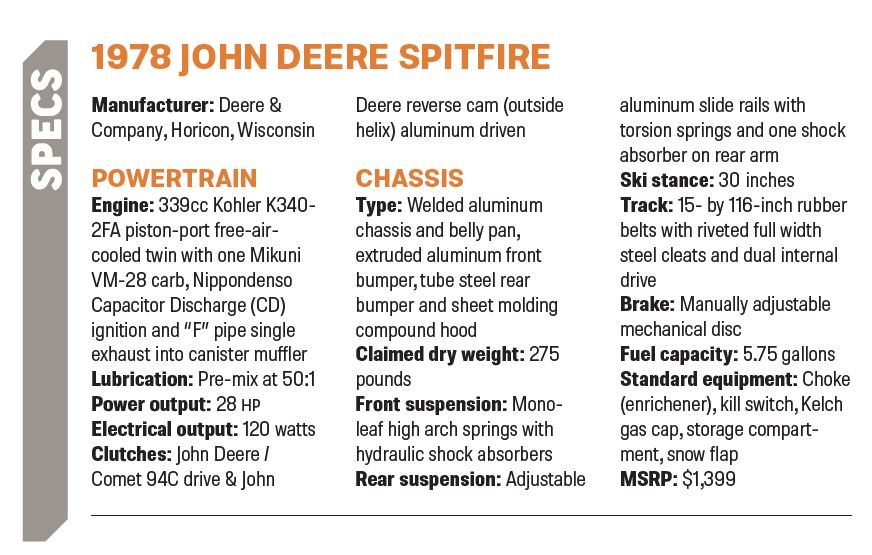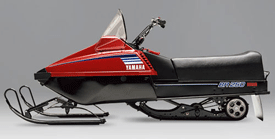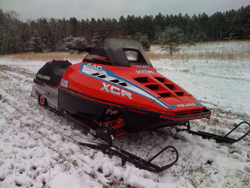1978 John Deere Spitfire: The Split Personality Sled

The John Deere Spitfire earned a place in snowmobile history as the first direct drive sled. And although popular at first, its sales declined quickly. Was it more fun than a barrel of monkeys (as some of us believed), or was it an accident looking for a place to happen, like detractors concluded?
The Beginning
The Spitfire began with a January 1976 conversation among a trio of snowbound John Deere engineers about how to reduce the cost of manufacturing snowmobiles. Ron Leonard, manager of engineering at the Horicon Works, asked project engineer Tom Lohr and powertrain engineer Dick Teal if the gearbox and jackshaft could be eliminated, and Teal determined that this approach might work. The two had race driver and development specialist Dale Cormican build a quick prototype at his shop to test the concept – christened “Little John,” it was deemed viable for commercial development.
Clutching was the major hurdle of the time for direct drive. The diameter of the driven clutch had to be increased, while the number of teeth on the drive axle sprockets was reduced to provide adequate all-around performance. A new drive clutch, the Comet 94C, was engineered for the project using pucks instead of ramps and rollers for simplicity and durability.
Porting of the Kohler free air engine was revised to move peak torque down to a lower RPM to go with the new clutching. Overall, nearly 40 parts were eliminated from the drivetrain, but a full-sized (for the day) track was still used. The final product was an unusually short, light and – most importantly – a less costly machine that still provided acceptable performance when ridden by an adult: top speed approached 55 mph.
Making its debut in 1977 for the 1978 model year, the “revolutionary” Spitfire replaced the now obsolete Model 300 at the low-end of the Deere lineup. A total of 8,024 Spitfires were built for its first season – an annual production number for the model that would not be reached again.
Marketed as the “lightest trail sled available and an ideal ride for a woman,” it was presented as the start of Deere & Company making snowmobiling more affordable by providing less expensive trail sleds that did not negatively impact performance.
When I got a chance to try one on the Vermont shore of Lake Champlain, I was frankly surprised by the Spitfire – agile, responsive and unusually comfortable for a small sled, it was really a fun ride and obviously I wasn’t the only one who felt that way. It sold well despite heavy dealership carryover of conventional Deere models. Many women were attracted to the Spitfire by the small size and lightweight build, while many men appreciated the same traits that allowed carrying it easily in a pickup truck bed rather than towing it on a trailer, making it popular with ice fishermen and other winter sportsmen.
But as much as people liked the Spitfire, a problem began to emerge: A very short chassis and steel-cleated track were a really bad combination on bare ice. The sled was easy to spinout in an icy corner, or on a frozen lake. If a rider was not careful, they could be tossed from or even flip the sled, potentially causing machine damage or personal injury.
Deere offered stamped steel star studs – considered state-of-the-art track stud technology of the time – as an option for the Spitfire to deal with ice. It is unknown how many customers bought them, but the stamped studs wore flat in a few hundred miles, which ended their usefulness quickly, so it wasn’t much of a solution anyway.
The Rest Of The Story
A major make-over for 1980 gave the Spitfire a comparable Kawasaki engine with slightly more power (but some claimed also less reliability), a newer but very similar track and new graphics. Deere joined other brands in using a racer for promotional work, with former Sno Pro competitor Stan Hayes explaining how much fun the light, little sled was to ride.
Production continued through the 1982 model year, but overall units decreased annually except for a slight uptick for the final season while the price rose steadily to $1,949. A total of 24,173 Spitfires were built during the model’s five-year production run.
The Spitfire proved that a direct drive snowmobile would work, and could be sold successfully. But it also generated customer satisfaction problems that Deere and Company didn’t want. Ultimately the Spitfire was superseded by the similar Snowfire – a slightly larger sled that never really had a chance as Deere sold its snowmobile business to Polaris in the middle of calendar year 1983.
Thanks to www.vintagesnowmobiles.50megs.com for the image. Click here to see other Timeline/Flashback articles on vintage snowmobiles.

Editor’s Note: Every Snow Goer issue includes in-depth sled reports and comparisons, aftermarket gear and accessories reviews, riding destination articles, do-it-yourself repair information, snowmobile technology and more. Subscribe to Snow Goer now to receive print and/or digital issues.



